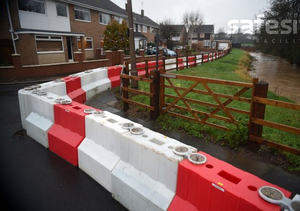Subscribe to our newsletter
Sign up for the latest news & offers from SafeSite
Quick and competitive quotes. Nationwide coverage
Quick quotes. Nationwide coverage
During periods of drought, the threat of flooding may not be immediately apparent. However, history has shown floods often follow extended dry spells. As Churchill once said, “The War Office is always preparing for the last war.” After the feast comes the famine. In this guide, we will explore the reasons behind the occurrence of floods after droughts and provide practical steps to prepare your construction site for potential flooding.
The three main types of flooding are:
Amidst a backdrop of the climate emergency, the severity and frequency of flash floods poses significant concern. Increased global temperatures lead to higher water vapour content in the atmosphere, resulting in heavier rainfall. Moreover, rising sea levels further contribute to coastal flooding, with high-tide flooding becoming increasingly prevalent.

Our flood defence barriers are the ideal solution for your site
While drought doesn’t directly cause rainfall, it significantly alters the condition of the soil. The lack of moisture during droughts bakes the soil, turning it into an impermeable surface that inhibits water absorption. When the ground is hardened, the probability and severity of flooding, particularly flash floods, are heightened.
To determine your level of flood risk, the UK government provides a useful online tool (for England) that allows you to check the flood risk associated with any address. Similar resources are available in other regions. These tools assess surface water risk separately from other forms of flooding, providing detailed flood maps. It’s important to evaluate your flood risk before undertaking any construction project. Knowing the risks and likelihood of an area or site being flooded allows you to plan your construction project accordingly, and to put proper precautions in place if needed.
When embarking on a construction project, flood risk assessment should be an integral part of the planning application process. However, ensuring the safety of your site during construction requires additional measures. Utilise the government tools mentioned earlier to evaluate your risk. You can develop a formal flood and evacuation plan by requesting a ‘flood history’ from the Environment Agency. A flood plan template can be downloaded to assist you in the preparation process. It is also recommended to review the general government advice on flood preparation for businesses.
Study the geography of your construction site to determine its drainage capacity. Investing in pumps and training staff in their use might be beneficial in areas with poor drainage. If operating pumps, ensure compliance with environmental permit requirements. Promptly address standing water and large puddles on the site to prevent avoidable flooding. During cold weather, periodically run water through pipes to prevent freezing. Additionally, follow the Health and Safety Executive’s guidelines to maintain a clear and tidy site, minimizing the risk of collapse and accidents.
In the event of a flood alert, relocate equipment and materials to higher or safer areas. Prioritise planning for the movement of hazardous substances, storing them in flood-safe locations whenever possible. Disconnect utilities and unplug electrical equipment. When handling switches or fuses in wet conditions, use a dry stick to avoid electric shock. Document the situation with ‘before and after’ photos for insurance purposes.
Avoid contact with floodwater whenever possible, as it may be contaminated with sewage, chemicals, or other harmful substances. Refrain from wading into water due to the risks of sharp objects or uncovered drains. Be aware most flood deaths are due to people driving vehicles into water that turns out to be deeper than thought.
The days of sandbags as the best flood defence are over. Modern flood barriers interconnect to form a solid barrier, self-filling with the floodwater to become stable.
Here at SafeSite Facilities, we can install this protection quickly after you receive an alert. If risk is high, though, you may wish to install such defences in advance.
Whoever you source barriers from can likely help in other ways, for example providing ground protection matting to turn a muddy surface into a safe walkway.
Using those mats from the start of construction stops people and machinery breaking up the ground and encouraging mud formation.
Contact SafeSite Facilities team of industry leading experts for our range of flood defence barriers and a free quote.
We respond in under 30 mins on average (excl. weekends)